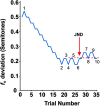Acuity to Changes in Self-Generated Vocal Pitch in Parkinson's Disease
- PMID: 32853119
- PMCID: PMC7890224
- DOI: 10.1044/2020_JSLHR-20-00003
Acuity to Changes in Self-Generated Vocal Pitch in Parkinson's Disease
Abstract
Purpose Given the role of auditory perception in voice production, studies have investigated whether impairments in auditory perception may underlie the noted disruptions in speech in Parkinson's disease (PD). Studies of loudness perception in PD show impairments in the perception of self-generated speech, but not external tones. Studies of pitch perception in PD have only examined external tones, but these studies differed in terms of the interstimulus intervals (ISIs) that were used, did not examine the impact of cognition, and report conflicting results. To clarify pitch perception in PD, this work investigated perception of self-generated vocal pitch, controlling for cognition and ISI. Method A total of 30 individuals with and without PD completed (a) hearing threshold testing, (b) the Montreal Cognitive Assessment, and (c) an adaptive just-noticeable-difference paradigm under two separate ISIs (100 ms and 1,000 ms) to assess acuity to self-generated vocal pitch. Results There was no significant difference in acuity between individuals with and without PD. Both groups demonstrated significantly worse acuity for longer compared to shorter ISIs. Montreal Cognitive Assessment scores were not a significant predictor of acuity. Conclusions The results suggest that acuity to self-generated vocal pitch does not differ between individuals with and without PD.
Figures



Similar articles
-
Vocal responses to perturbations in voice auditory feedback in individuals with Parkinson's disease.PLoS One. 2012;7(3):e33629. doi: 10.1371/journal.pone.0033629. Epub 2012 Mar 20. PLoS One. 2012. PMID: 22448258 Free PMC article.
-
Loudness Perception of Pure Tones in Parkinson's Disease.J Speech Lang Hear Res. 2018 Jun 19;61(6):1487-1496. doi: 10.1044/2018_JSLHR-H-17-0382. J Speech Lang Hear Res. 2018. PMID: 29800039 Free PMC article.
-
External cueing facilitates auditory-motor integration for speech control in individuals with Parkinson's disease.Neurobiol Aging. 2019 Apr;76:96-105. doi: 10.1016/j.neurobiolaging.2018.12.020. Epub 2019 Jan 8. Neurobiol Aging. 2019. PMID: 30710834
-
Sensory Feedback in Parkinson Disease Voice Production: A Systematic Review.J Voice. 2025 Mar 19:S0892-1997(25)00088-8. doi: 10.1016/j.jvoice.2025.02.039. Online ahead of print. J Voice. 2025. PMID: 40113519 Review.
-
Effects of intensive speech treatment on Mandarin speakers with Parkinson's Disease: A review.Medicine (Baltimore). 2023 Feb 10;102(6):e32900. doi: 10.1097/MD.0000000000032900. Medicine (Baltimore). 2023. PMID: 36820601 Free PMC article. Review.
Cited by
-
A neurocomputational view of the effects of Parkinson's disease on speech production.Front Hum Neurosci. 2024 May 15;18:1383714. doi: 10.3389/fnhum.2024.1383714. eCollection 2024. Front Hum Neurosci. 2024. PMID: 38812472 Free PMC article.
-
Impaired auditory discrimination and auditory-motor integration in hyperfunctional voice disorders.Sci Rep. 2021 Jun 23;11(1):13123. doi: 10.1038/s41598-021-92250-8. Sci Rep. 2021. PMID: 34162907 Free PMC article.
-
The Relationship Between Pitch Discrimination and Fundamental Frequency Variation: Effects of Singing Status and Vocal Hyperfunction.J Voice. 2025 Jul;39(4):1076-1084. doi: 10.1016/j.jvoice.2023.01.008. Epub 2023 Feb 6. J Voice. 2025. PMID: 36754684 Free PMC article.
-
Feedback and Feedforward Auditory-Motor Processes for Voice and Articulation in Parkinson's Disease.J Speech Lang Hear Res. 2021 Dec 13;64(12):4682-4694. doi: 10.1044/2021_JSLHR-21-00153. Epub 2021 Nov 3. J Speech Lang Hear Res. 2021. PMID: 34731577 Free PMC article.
-
Evaluation of multi-feature auditory deviance detection in Parkinson's disease: a mismatch negativity study.J Neural Transm (Vienna). 2021 May;128(5):645-657. doi: 10.1007/s00702-021-02341-z. Epub 2021 Apr 24. J Neural Transm (Vienna). 2021. PMID: 33895941
References
-
- Abur, D. , Lester-Smith, R. A. , Daliri, A. , Lupiani, A. A. , Guenther, F. H. , & Stepp, C. E. (2018). Sensorimotor adaptation of voice fundamental frequency in Parkinson's disease. PLOS ONE, 13(1), e0191839 https://doi.org/10.1371/journal.pone.0191839 - PMC - PubMed
-
- Abur, D. , Lupiani, A. A. , Hickox, A. E. , Shinn-Cunningham, B. , & Stepp, C. E. (2017). Loudness perception of pure tones in Parkinson's disease. The Journal of the Acoustical Society of America, 141(5), 3900 https://doi.org/10.1121/1.4988772 - PMC - PubMed
-
- Alain, C. , Woods, D. L. , & Knight, R. T. (1998). A distributed cortical network for auditory sensory memory in humans. Brain Research, 812(1–2), 23–37. https://doi.org/10.1016/S0006-8993(98)00851-8 - PubMed
-
- Anand, S. , & Stepp, C. E. (2015). Listener perception of monopitch, naturalness, and intelligibility for speakers with Parkinson's disease. Journal of Speech, Language, and Hearing Research, 58(4), 1134–1144. https://doi.org/10.1044/2015_JSLHR-S-14-0243 - PMC - PubMed
-
- Aronson, A. E. , & Brown, J. R. (1975). Motor speech disorders. WB Saunders Company.
Publication types
MeSH terms
Grants and funding
LinkOut - more resources
Full Text Sources
Medical

